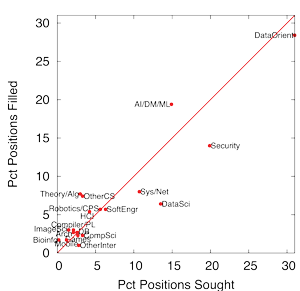2018 Computer Science Tenure-Track Faculty Hiring Outcomes
By Craig Wills, Worcester Polytechnic Institute

This work directly follows previous work that analyzed current and future Computer Science needs via advertised tenure-track faculty searches for 2018. This follow-on work looks to understand the relative success of institutions in hiring the tenured/tenure-track faculty in the areas of Computer Science that were being sought.
Responses to a survey were obtained from 176 institutions that reported seeking tenure-track faculty in 2018. Survey respondents reported seeking 363 tenure-track faculty positions and filling 269 such positions for an aggregate success rate of 74%. Examination on the success of the search for each of the institutions found that 22% failed to hire any faculty, while 54% succeeded in hiring at least as many faculty as were being sought. These survey results are similar to 2017.
In terms of results for different types of institutions, the top-100 PhD institutions had the smallest reported failed search rate of 7% while BS institutions had the highest reported failed search rate of 31%. Public PhD (62%) and private PhD (58%) institutions had the highest rate of hiring at least as many faculty as were being sought. Public MS&BS (48%) institutions had the lowest reported rate in hiring as many faculty as were being sought.
Reported results on the previous position for hired faculty show that three types of such positions predominant. 29% of hired faculty start with a newly-earned PhD, 27% were previously in a tenured or tenure-track position at another institution and 23% were previously in a post-doc/researcher position. These results are similar to those in 2017.
In comparing the areas of filled positions with the areas in which positions were sought, the area of Security showed the biggest negative difference with 14% of filled positions, but 20% of sought positions. Data-oriented areas, consisting of AI/DM/ML (Artificial Intelligence, Data Mining and Machine Learning), Data Science and Databases, accounted for 31% of sought positions and 28% of filled positions. In general, the net percentage differences between areas sought and filled were smaller than similar results in 2017.

Taulbee Survey results were used to compare areas of PhD production with areas of faculty positions sought and filled. Security is the area with most obvious discrepancy between percentage of PhDs produced (4%) and faculty positions sought (20%). Security and AI/DM/ML are the areas with the highest discrepancy between PhDs produced and positions filled with a net of 10% and 6% more positions filled than PhDs produced.
The full report containing a description of the methodology and the complete results is available at http://www.cs.wpi.edu/~cew/papers/outcomes18.pdf.
At the 2018 Conference at Snowbird, a session on Tuesday, July 17 titled “Improving Faculty Recruiting in the Computing Community” will discuss faculty recruiting challenges faced by departmental leadership (e.g., low yield), faculty members (e.g., multiple candidates per week), and faculty candidates (e.g., many strong candidates not getting academic interviews). It will also assess the needs, if any, for computing research community action.



